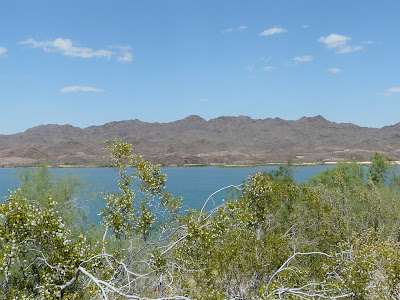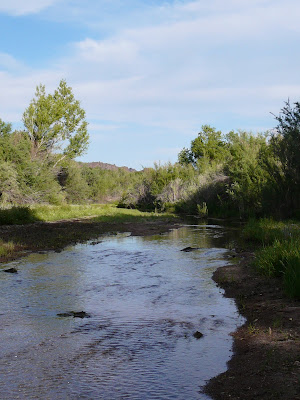All of this beautiful scenery is right outside the office and Visitor's Center. In the photo below, you can see one of two main trails offered at the refuge: the penisula trail with water on both sides. It was a great place to take a break from work and hosts several informational kiosks, benches, and three covered fishing piers that are free and open to the public.
Butterflies also love the water, temps, plants and habitat of Bill Williams River. A total of 34 species of butterflies have been documented on the refuge.
Some more sights from the Penisula Trail.
The Bill Williams River and Refuge are named for a Mountain Man from the early 1800s who lived and explored the area (Bill Shirley Williams).
The refuge also hosts a small pond of the endangered desert pupfish. Similar set-ups are found at many oher refuges that are also trying to protect it from extinction.
The other trail at BWR is the 3-mile Planet Ranch access road that takes the visitor on a path that parallels the BW river and leads to many off-shoot trails and some more incredible scenery.
There is a long patch of green that you will see throughout these photos. BWRNWR supports the last and largest remnant of the native riparian habitats that once filled the valleys of the lower Colorado River and its tributaries. Specifically, the refuge hosts natural cottonwood-willow forests that provide homes for many once common species that have become rare due to habitat changes over the last 100 years. Since the Hoover Dam was built up-river in 1935, followed by 20 smaller dams in the decades after that, the water has backed up into a series of lakes, drowning many of the natural riparian forests along the shores of the Colorado River in the process.
This bench is at the end of the Penisula Trail and provides a delightful place to sit and take in the sights: blue-green water, boaters, birds, mountains, cliffs and plenty of sunshine.
One of the trails off of the Planet Ranch Road leads the hiker back to the river. It is a long and mostly shaded trail where you could get a close-up view of the trees and riparian habitat for the birds. It was worth the walk back (and slightly wet hiking boots) to see the Bill Williams River.
This is Kathleen, the refuge ecologist for the past 16 years. She is passionate about her work and is a source of much history and knowledge about all of the animals, plants and evolution of the landscape at BWR. We enjoyed her energy and hearing her stories about some of the wonderful things happening here. Don't you just love her office? It is loaded with info on the refuge. Below Oliver works away in our space at the refuge HQ.
The BWR NWR does not have visitor housing, so we visited here on two different work days to scan their files. We then took several boxes back to Havasu NWR, up the river/road about 30 minutes to scan there. The two refuges are a "complex" and therefore work in tandem and share some resources. We stayed in a fabulous 2 BR house at Havasu and commuted to Bill Will. We visited BWR and hiked there on a 3rd occasion at the end of a day where we cruised the Topock Gorge section of the Co River, through the Havasu NWR (post to come soon). This arrangement worked great and allowed us to be able to support both refuges with this preservation project.
We thought that this great blue heron was pretty funny. He was waiting for some leftover bait or the chance to dibs on whatever this fisherman decided to throw back. He was no dummy!
Great information found inside the BWR Visitor's Center.
These are two more terrific people connected to the Bill Williams River NWR. Pam is above and commutes between both refuges as admin support. She was a great friend to us during our time there and helped to make our visit easier and more comfortable. Below is Mr Dick Gilbert, Manager at BWR and pushing 47 years in the FWS. Although he could retire tomorrow, he too loves his work and is not ready to step away just yet. We so enjoyed meeting and working with all of the good folks at BWR and Havasu NWRs.
Can you see Oliver in the photos below? He was able to run the refuge on each of our visits to BWR.
More cool hiking spots at Bill Will.
These next few photos are of the refuge HQ and penisula trail taken from the highway heading south towards Parker, AZ and from a higher vantage point.
These final images are of the mouth of the Bill Williams River, heading back inside the refuge itself (from the highway), paralleling the Planet Ranch access road. The Bill Williams and Gila Rivers are the only two tributaries of the Colorado River below the Grand Canyon. This is a "no wake" zone, but open to kayaks and canoes.





















































































































































No comments:
Post a Comment